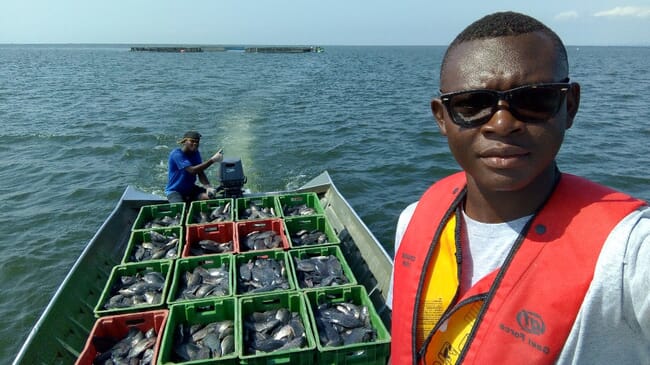
Ghanaian regulations dictate that Ghana’s tilapia farmers must use variants of the Akosombo strain, which was developed in the last decade for domestic use at the Aquaculture Research and Development Centre (ARDEC) of Ghana’s Water Research Institute (WRI). However, new trials present a strong argument – from a growth perspective – of switching to the genetically improved farmed tilapia (GIFT strain), which was developed for use in Asian by the predecessor WorldFish in the 1980s.
What’s more, the authors of the new study observe, WorldFish – having initially argued against the introduction of the GIFT strain to Africa, have supported its use since 2007 – not least due to its rapid improvement in growth rates, but also due to the fact that the base population for selection of GIFT was composed from four wild African strains (including a Ghanaian strain) and four farmed Asian strains (of which three originated from Ghana).
Trial methodology
During the recent trials, the growth performance and survival to harvest of the Akosombo strain generation 10 and the GIFT strain generation two (derived from GIFT generation 11 in Malaysia) were evaluated.
The fish were from 96 families of the Akosombo selected line (AKOS), 30 of the Akosombo control line (AKOC), and 22 of the GIFT strain (GIFT). In total, 11,812 tagged fingerlings were stocked at a density of 3 fish per m2 into two ponds, each 2000 m2.
The fish were all fed 38 percent crude protein pelleted feed, twice daily, at a rate of 5 percent body weight, for 120 days. Harvest weight of GIFT (150.1 ± 58.5 g) was 2.2 times larger than AKOC (67.6 ± 28.4 g) and 1.8 times larger than the AKOS (85.2 ± 32.0 g) strains. The least-squares mean weight of male GIFT were 98.6 g more than AKOC and 82.7 g more than AKOS. The corresponding ratios for females were even greater, with female GIFT weighing 106.5 g more than AKOC, and 89.9 g more than AKOS. The AKOS grew larger than the AKOC, 15.9 g larger for males and 16.6 g for females.
Moreover survival rates were comparable – with GIFT survival being 55.2 percent, AKOS 54.5 percent and AKOC 50.0 percent.
Conclusions
While the authors of the concede that the Akosombo programme “has successfully produced, over 10 years of selection, a strain that grows about 30 percent faster than unimproved Ghanaian stocks” they also note that their data “suggest a fundamental genetic difference with respect to growth rates between the Akosombo and GIFT strains.”
They allude to the debate over the concerns of using imported elite strains rather than native ones – both from a conservation angle and in terms of the extent to which these strains are adapted to local ecosystems.
“These issues will be debated in respect of the choice of strain for use in the development of the aquaculture industry in Ghana and the Volta basin at large,” they note.
However, their conclusions appear to favour the use of GIFT, on balance.
“The data suggest that it would require more than 20 years of selection for the Akosombo strain to achieve similar levels of growth to the GIFT strain generation tested, during which time continued selection of GIFT would result in even greater improvement in performance. Use of GIFT would be expected to provide a huge boost in commercial tilapia production in Ghana and the sub-region,” they conclude.


